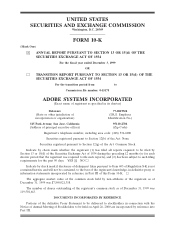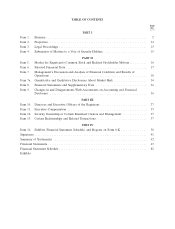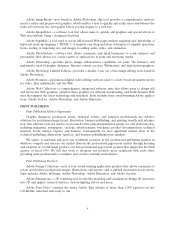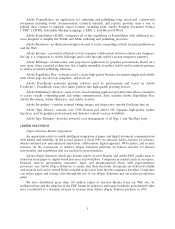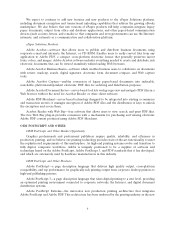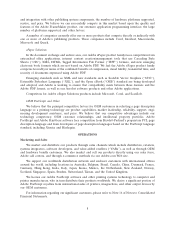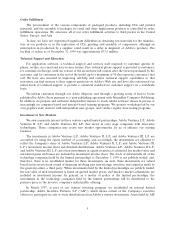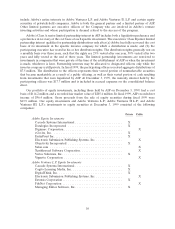Adobe 1999 Annual Report Download - page 9
Download and view the complete annual report
Please find page 9 of the 1999 Adobe annual report below. You can navigate through the pages in the report by either clicking on the pages listed below, or by using the keyword search tool below to find specific information within the annual report.8
and integration with other publishing system components, the number of hardware platforms supported,
service, and price. We believe we can successfully compete in this market based upon the quality and
features of the Adobe FrameMaker product, our extensive application programming interface, the large
number of platforms supported, and other factors.
A number of companies currently offer one or more products that compete directly or indirectly with
one or more of Adobe’s publishing products. These companies include Corel, Interleaf, Macromedia,
Microsoft, and Quark.
ePaper Solutions
In the document exchange and archive area, our Adobe ePaper product family faces competition from
entrenched office applications, internet content creation/management tools that use Cascading Style
Sheets (‘‘CSS’’), XML, HTML, Tagged Information File Format (‘‘TIFF’’) formats, and new emerging
electronic book formats which are not based on Adobe PDF. We feel the Adobe ePaper product family
competes favorably in terms of the combined benefits of compression, visual fidelity, transmittal time, and
security of documents expressed using Adobe PDF.
Emerging standards such as XML and new standards such as Scalable Vector Graphics (‘‘SVG’’),
Extensible Stylesheet Language (‘‘XSL’’), and the Open eBook (‘‘OEB’’) standard are being developed
and adopted, and Adobe is working to ensure that compatibility exists between these formats and the
Adobe PDF format, as well as our Acrobat software products and other Adobe applications.
Competitors for Adobe ePaper Solutions products include Microsoft, Corel, and ScanSoft.
OEM PostScript and Other
We believe that the principal competitive factors for OEM customers in selecting a page description
language or a printing technology are product capabilities, market leadership, reliability, support, engi-
neering development assistance, and price. We believe that our competitive advantages include our
technology competency, OEM customer relationships, and intellectual property portfolio. Adobe
PostScript and Adobe PrintGear software face competition from Hewlett-Packard’s proprietary PCL page
description language and from developers of page description languages based on the PostScript language
standard, including Xionics and Harlequin.
OPERATIONS
Marketing and Sales
We market and distribute our products through sales channels which include distributors, retailers,
systems integrators, software developers, and value-added resellers (‘‘VARs’’), as well as through OEM
and hardware bundle customers. We also market and sell our products directly using our sales force,
Adobe call centers, and through e-commerce methods via our Adobe.com Web site.
We support our worldwide distribution network and end-user customers with international offices
around the world, including locations in Australia, Belgium, Brazil, Canada, China, Denmark, France,
Germany, Hong Kong, India, Italy, Japan, Korea, Mexico, the Netherlands, New Zealand, Norway,
Scotland, Singapore, Spain, Sweden, Switzerland, Taiwan, and the United Kingdom.
We license our Adobe PostScript software and other printing systems technology to computer and
printer manufacturers, who in turn distribute their products worldwide. We derive a significant portion of
Adobe PostScript royalties from international sales of printers, imagesetters, and other output devices by
our OEM customers.
For information regarding our significant customers, please refer to Note 16 of Notes to Consolidated
Financial Statements.

